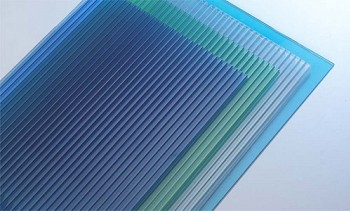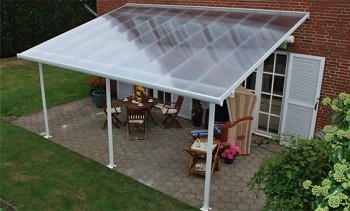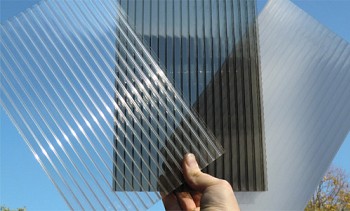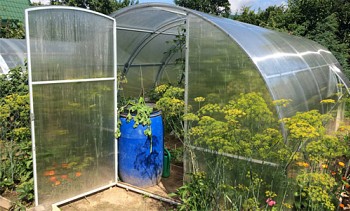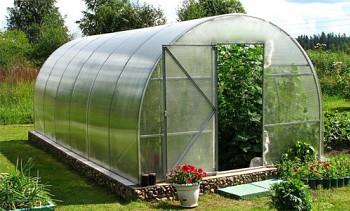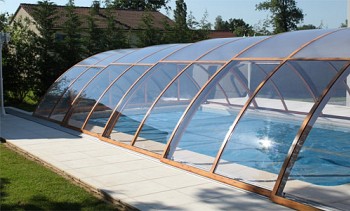Polymeric materials are widely used in the construction of buildings and structures for various purposes. Cellular polycarbonate is a two- or three-layer panel with longitudinal stiffeners located between them. The cellular structure provides high mechanical strength of the sheet with a relatively small specific gravity. To understand and understand all the technical characteristics of cellular polycarbonate, consider its properties and parameters in more detail.
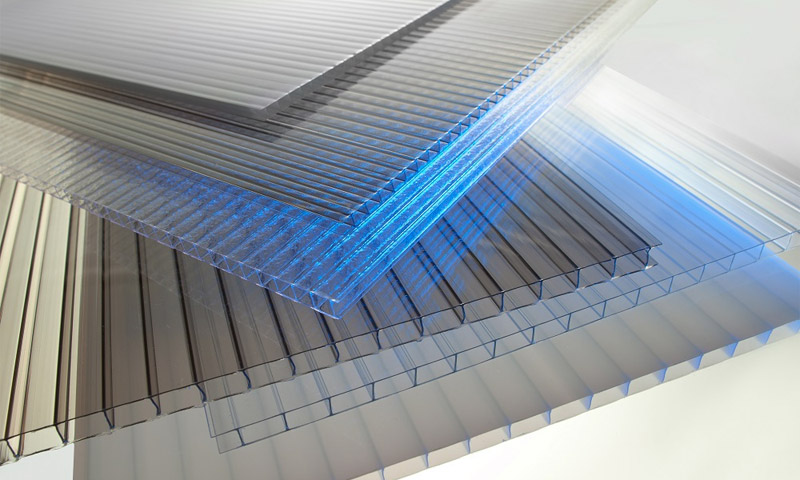
Content:
- What is cellular polycarbonate?
- Temperature conditions for the use of cellular polycarbonate
- Chemical resistance of the material
- The mechanical strength of cellular polycarbonate
- Sheet thickness and specific gravity
- UV resistance of cellular polycarbonate
- Thermal insulation properties of cellular polycarbonate
- Fire performance
- Lifetime
- Soundproofing
- Moisture resistant
- Panel colors
- Purpose and scope of the material
- The difficulty of installing cellular polycarbonate
What is cellular polycarbonate?
In cross section, the sheet resembles a honeycomb of rectangular or triangular shape, hence the name of the material. The raw material for it is granular polycarbonate, which is formed as a result of condensation of carbonic acid polyesters and dihydroxyl compounds. The polymer belongs to the group of thermosetting plastics and has a number of unique properties.
Industrial production of cellular polycarbonate is carried out using extrusion technology from granular raw materials. Production is carried out in accordance with the technical specifications of TU-2256-001-54141872-2006. The specified document is also used as a guide for the certification of material in our country.
The main parameters and linear dimensions of the panels must strictly comply with the requirements of the standards.
The cross-sectional structure of cellular polycarbonate can be of two types:

His sheets are issued with the following structure:

2H - Two-layer with rectangular cells.

3X - a three-layer structure with a combination of rectangular cells with additional inclined partitions.

3H - three-layer sheets with a rectangular honeycomb structure, produced with a thickness of 6, 8, 10 mm.

5W - five-layer sheets with a rectangular honeycomb structure, as a rule, have a thickness of 16 - 20 mm.

5X - five-layer sheets consisting of both straight and inclined ribs, are produced with a thickness of 25 mm.
The linear dimensions of the sheets of polycarbonate honeycomb are shown in the table:
| Characteristics | Units measuring | Options | |||||||
|---|---|---|---|---|---|---|---|---|---|
| Sheet thickness | mm | 4 | 6 | 8 | 10 | 16 | 16 | 20 | 25 |
| The number of layers (walls) | 2H | 2H | 2H | 2H | 3X | 3H | 6H | 5X | |
| Honeycomb structure |  |
 |
 |
 |
 |
||||
| The distance between the ribs | mm | 6 | 6 | 10,5 | 10,5 | 25 | 16 | 20 | 20 |
| Sheet width | m | 2,1 | 1,2 | ||||||
| Minimum bending radius | m | 0,7 | 0,9 | 1,2 | 1,5 | 2,4 | 2,4 | 3,0 | Not recommended |
| Sheet weight | kg / m2 | 0,8 | 1,3 | 1,5 | 1,7 | 2,5 | 2,8 | 3,1 | 3,4 |
| Panel Length | mm | 6000 and 12000 (deviation from the nominal size of 1.5 mm for transparent sheets and 3 mm for color is allowed) |
|||||||
It is allowed to produce panels with other parameters besides those specified in the technical conditions in agreement with the customer. The thickness of the stiffeners is determined by the manufacturer, the maximum permissible deviation for this value is not set.
Temperature conditions for the use of cellular polycarbonate
Cellular polycarbonate is extremely resistant to adverse environmental conditions. Temperature operating conditions directly depend on the brand of this material, the quality of raw materials and compliance with production technology. For the vast majority of types of panels, this figure is from -40 ° C to + 130 ° C.
Some types of polycarbonate can withstand extremely low temperatures up to - 100 ° C without destroying the structure of the material. When heating or cooling the material, its linear dimensions change. The coefficient of linear thermal expansion for this material is 0.0065 mm / m- ° C, determined in accordance with DIN 53752. The maximum allowable expansion of cellular polycarbonate should not exceed 3 mm per 1 m, both in length and in sheet width. As you can see, polycarbonate has a significant thermal expansion, which is why during its installation it is necessary to leave the appropriate gaps.

Change in linear dimensions of cellular polycarbonate depending on the ambient temperature.
Chemical resistance of the material
The panels used for decoration are exposed to a wide variety of destructive factors. Cellular polycarbonate is highly resistant to most chemical inert substances and compounds.
The use of sheets in contact with the following materials is not recommended:
1. Cement mixes and concrete.
2. PVC plasticized.
3. Aerosols are insecticidal.
4. Strong detergents.
5. Sealants based on ammonia, alkali and acetic acid.
6. Halogen and aromatic solvents.
7. Methyl alcohol solutions.

Polycarbonate has a high chemical resistance to the following compounds:
1. Concentrated Mineral Acids.
2. Saline solutions with a neutral and acid reaction.
3. Most types of reducing agents and oxidizing agents.
4. Alcohol solutions, with the exception of methanol.

When mounting sheets, silicone sealants and specially designed EPDM sealing elements and analogues should be used for them.
The mechanical strength of cellular polycarbonate
Panels due to their honeycomb structure can withstand significant loads. However, the surface of the sheet is subject to abrasion during prolonged contact with small particles such as sand. Scratching is possible when in contact with rough materials of sufficient hardness.
The indicators of the mechanical strength of polycarbonate largely depend on the grade and structure of the material.
During testing, the panels showed the following results:
| Units | Premium | Economy class | |
|---|---|---|---|
| Tensile strength | MPa | 60 | 62 |
| Relative strain upon reaching ultimate strength | % | 6 | 80 |
| Yield strength | MPa | 70 | - |
| Relative deformation upon reaching yield strength | % | 100 | - |
| Impact Viscosity | kJ / mm | 65 | 40 |
| Elastic deformation | kJ / mm2 | 35 | - |
| Brinell hardness indices | MPa | 110 | - |
Checking cellular polycarbonate for strength indicators is carried out in accordance with ISO 9001: 9002. The manufacturer guarantees the preservation of performance for at least five years, subject to the correct installation of sheets and the use of special fasteners.
Sheet thickness and specific gravity
Production technology provides the ability to manufacture cellular polycarbonate of various sizes. Currently, the industry produces panels with a thickness of 4, 6, 8, 10, 16, 20 and 25 mm with different internal structure of the panels. The density of polycarbonate is 1.2 kg / m 3, determined by the measurement method provided for in DIN 53479.
For panels, this indicator depends on the thickness of the panel, as well as on the number of layers and the pitch of the stiffeners and their cross-sectional area.
For most common brands of cellular polycarbonate, the data are shown in the table:
| Sheet thickness mm | 4 | 6 | 8 | 10 | 16 | 16 | 16 | 20 | 25 |
| Number of walls | 2 | 2 | 2 | 2 | 3 | 3 | 6 | 6 | 5 |
| Step of stiffeners, mm | 6 | 6 | 10,5 | 10,5 | 25 | 16 | 20 | 20 | 20 |
| Specific weight, kg / m- | 0,8 | 1,3 | 1,5 | 1,7 | 2,5 | 2,8 | 2,8 | 3,1 | 3,4 |
UV resistance of cellular polycarbonate
The characteristics of cellular polycarbonate are able to provide reliable protection against brutal radiation in the UV range. To achieve this effect in the production process, a layer of a special stabilizing coating is applied to the sheet surface by coextrusion.This technology is guaranteed to provide a minimum life of the material for 10 years.
Moreover, the peeling of the protective coating during operation does not occur due to the fusion of the polymer with the base. When installing the sheet, you should carefully inspect the marking and orient it correctly. The UV protection coating should face outwards. The light transmission of the panel depends on its color and for unpainted sheets this indicator is from 83% to 90%. Transparent color panels transmit no more than 65%, while polycarbonate perfectly diffuses the light transmitted through them.

Thermal insulation properties of cellular polycarbonate
Cellular polycarbonate has very decent thermal insulation characteristics. Moreover, the heat resistance of this material is achieved not only due to the fact that it contains air, but also because the material itself has greater thermal resistance than glass or PMMA of the same thickness. The heat transfer coefficient, which characterizes the heat-insulating properties of the material, depends on the thickness and structure of the sheet. It ranges from 4.1 W / (m² · K) (for 4 mm) to 1.4 W / (m² · K) (for 32 mm). Cellular polycarbonate is the most acceptable material where transparency and high thermal insulation are to be combined. That is why this material has become so popular in the production of greenhouses.

Polycarbonate industrial greenhouse.
Fire performance
Cellular polycarbonate is resistant to high temperature influences. This material belongs to category B1, which is classified as self-extinguishing and flame-resistant by the European classification. When burning, polycarbonate does not emit toxic and dangerous gases for humans and animals.
Under the influence of high temperature and open flame, the structure is destroyed and through holes are formed. Material significantly decreases in area and moves away from the heat source. The appearance of holes ensures the removal of combustion products and excess heat from the fire source.
Lifetime
Manufacturers of cellular polycarbonate guarantee the preservation of the basic technical characteristics of the material for a service life of up to 10 years, subject to the rules of installation and care. The outer surface of the sheet has a special coating that provides protection from ultraviolet radiation. Damage to it significantly reduces the life of the panel and leads to its premature destruction.
In places where there is a risk of mechanical damage to polycarbonate, sheets with a thickness of at least 16 mm should be used. When installing panels, the need to exclude contact with substances, the long-term exposure of which contributes to their destruction, is taken into account.
Soundproofing
The honeycomb structure of polycarbonate contributes to the low acoustic permeability of the material. The panels have a pronounced soundproofing property, which directly depends on the type of sheet and its internal structure. Multilayer cellular polycarbonate with a thickness of 16 mm or more provides the extinction of sound waves in the range of 10-21 dB.
Moisture resistant
This sheet material does not pass and does not absorb moisture, which makes it indispensable for roofing. The main difficulty in the interaction of cellular polycarbonate with water lies in its penetration into the panel. Removing it without dismantling the structures is almost impossible.

The prolonged presence of moisture in the combs can cause its blooming and gradual destruction.
In order to exclude such a development of events, only special fasteners with sealing elements should be used in the installation process. The edges of the polycarbonate are glued with a special tape. The easiest way to clean the cells is to purge them with compressed air from a cylinder or compressor.

To protect the edge from moisture, apply: 1. - special adhesive tape, 2.- A special profile, which is put on top of the glued tape.
Panel colors
Cellular polycarbonate is marketed in transparent and tinted versions.
Manufacturers offer the consumer panels in the following colors:
There is also a completely opaque version of the panels in silver. The light transmission of cellular polycarbonate depends on its thickness and its internal structure. For a transparent material, the light transmission is from 86% for 4 mm sheet, up to 82% for 16 mm material. Coloring of the material is carried out in an array, which contributes to the preservation of color throughout the entire life cycle.
Purpose and scope of the material
Cellular polycarbonate is mainly used in construction for the erection of roofs and building envelopes.
This material, due to its exceptional properties, is increasingly used for the manufacture of the following elements:
In private households, such panels are used for glazing verandas, attics, arbors or summer kitchens. Another area of application of the panels is the production of agricultural greenhouses, which are durable.
The difficulty of installing cellular polycarbonate
Installation of cellular polycarbonate is carried out by mounting on a frame made of steel or aluminum profile. Bending of sheets across stiffeners is allowed, this property is widely used in the manufacture of visors and roofs. The minimum radius of curvature of the panel depends on its thickness inversely. Cellular polycarbonate 25 mm thick is not subject to bending.
When performing installation, a number of rules must be followed:

1. Cutting panels up to 10 mm thick is carried out with a sharpened knife, a saw with small teeth
2. Drilling is carried out with a drill. The minimum distance from the edge is at least 40 mm.


3. The panels are attached to the frame using self-tapping screws with sealing washers
4. Separate sheets are joined together using special connecting elements



















